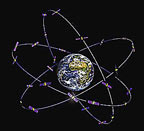
Thirty years ago, February 22, 1978, the US Military put
into orbit the first satellite, one of a group of 24, known today as GPS, Global
Positioning System.
The human being has a basic need to position himself in space and time. Older
instruments such as the hour-glass, sundial, astrolabe, compass and sextant
first filled this need. These instruments were indispensable on long voyages.
When land vanished from sight, it was necessary to use other references such as
the magnetic field and celestial bodies, including the stars.
With GPS it is not necessary to know how to use a compass or to read the stars
to determine position. It is a time of convenience. We can reach a destination
with little effort. If the human being no longer needs to know how to navigate
by the stars to position himself on earth, they are useful for orienting the
heart and the spirit.
One should not lose the capacity to rely on the brilliance of the starry sky,
because a life focused only on the material and the mundane, on work and
entertainment, is a life more akin to that of a beast of burden.
To be a human being is to be an agent of consciousness, which permits the
awakening to a mystery that is greater than oneself and the immediate
surrounding: the stars, the galaxies and the infinite universe. With such a
consciousness, the human being, even isolated, excluded or ostracized, is never
alone.
As human beings, we belong not only to the Earth, but equally to the cosmos.